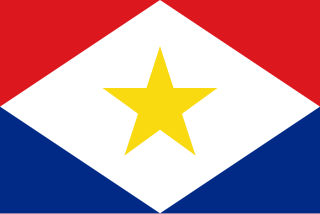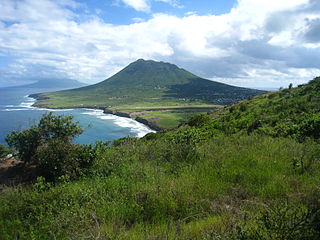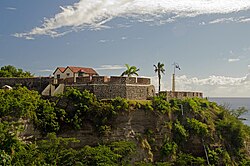
The Netherlands Antilles was a constituent country of the Kingdom of the Netherlands. The country consisted of several island territories located in the Caribbean Sea. The islands were also informally known as the Dutch Antilles. The country came into being in 1954 as the autonomous successor of the Dutch colony of Curaçao and Dependencies. The Antilles were dissolved in 2010. The Dutch colony of Surinam, although relatively close by on the continent of South America, did not become part of the Netherlands Antilles but became a separate autonomous country in 1954. All the island territories that belonged to the Netherlands Antilles remain part of the kingdom today, although the legal status of each differs. As a group they are still commonly called the Dutch Caribbean, regardless of their legal status. People from this former territory continue to be called Antilleans in the Netherlands.

Saba is a Caribbean island and the smallest special municipality of the Netherlands. It consists largely of the active volcano Mount Scenery, which at 887 metres (2,910 ft) is the highest point of the entire Kingdom of the Netherlands. The island lies in the northern Leeward Islands portion of the West Indies, southeast of the Virgin Islands. Together with Bonaire and Sint Eustatius it forms the BES islands, also known as the Caribbean Netherlands.

Sint Eustatius, known locally as Statia, is an island in the Caribbean. It is a special municipality of the Netherlands.

Oranjestad is a small town of 1,038 inhabitants; it is the capital and largest town of the island of Sint Eustatius in the Caribbean Netherlands. It’s not to be confused with the far larger Oranjestad in Aruba.
The Democratic Party is a political party in Sint Eustatius with two seats in the 5-seat island council. In 2011, the party obtained 2 seats in the first elections after Sint Eustatius became part of the Netherlands upon the dissolution of the Netherlands Antilles in 2011. However, their Island Council representative Reuben Merkman left the DP in 2014 and became an independent council member.

The Quill, also known as Mount Mazinga, is a stratovolcano located on the island of Sint Eustatius in the Caribbean Netherlands. The summit elevation is 601 m (1,972 ft) above sea level. It is also the second highest mountain in the Netherlands.

The flag of Caribbean Netherlands island of Sint Eustatius (Statia) consists of a blue field, red fimbriations, and in the center, a white diamond with a silhouette of the island. The flag was designed by Zuwena Suares and adopted on 29 July 2004 to be put into use on 16 November of that year. Since 2010, it has been the official flag of the special municipality of Sint Eustatius.

F. D. Roosevelt Airport is the airport located on the island of Sint Eustatius, Caribbean Netherlands. It was opened as "Golden Rock Airport" in 1946 and renamed for Franklin Delano Roosevelt. As of 2012, the only commercial aircraft that serves the island is the DHC-6 Twin Otter, although the runway can accommodate larger turboprop aircraft and some smaller jets. As of 2023, the largest aircraft type to operate at the airport is the ATR 42.

Johannes de Graaff (1729–1813), also referred to as Johannis de Graeff in some documents, was a Dutch Governor of Sint Eustatius, Saba and Sint Maarten in the Netherlands Antilles representing the Dutch West India Company during the difficult time of the American Revolutionary War.

The Caribbean Netherlands is a geographic region of the Netherlands located outside of Europe, in the Caribbean, consisting of three so-called special municipalities. These are the islands of Bonaire, Sint Eustatius and Saba, as they are also known in legislation, or the BES islands for short. The islands are officially classified as public bodies in the Netherlands and as overseas territories of the European Union; as such, European Union law does not automatically apply to them.
Fort Orange may refer to:

The Dutch Caribbean are the New World territories, colonies, and countries of the Dutch Empire and the Kingdom of the Netherlands located in the Caribbean Sea, mainly the northern and southwestern regions of the Lesser Antilles archipelago.

St. Eustatius Church is a parish of the Catholic Church in Oranjestad, Sint Eustatius, the capital of the Caribbean island of St. Eustatius, in the Dutch Caribbean.
Same-sex marriage has been legal in Bonaire, Sint Eustatius and Saba since 10 October 2012, the effective date of legislation passed by the States General of the Netherlands enabling same-sex couples to marry.

The COVID-19 pandemic in Sint Eustatius is part of the ongoing global viral pandemic of coronavirus disease 2019 (COVID-19), which was confirmed to have reached the Dutch Caribbean island of Sint Eustatius on 31 March 2020. On 5 May all cases recovered. The island's first COVID-19 death was recorded on 19 January 2022. The patient died at the St. Maarten Medical Center (SMCC) where they had been transported for treatment according to the press release of the St. Eustatius government.
The Sint Eustatius national football team is the national association football team of the Caribbean island of Sint Eustatius. It is a not member of the Caribbean Football Union, CONCACAF, or FIFA and therefore cannot compete in tournaments sanctioned by these organizations. It is under the auspices of the Statia Football Association.
Claudia Toet is a Dutch politician from The Hague who was appointed Deputy Government Commissioner of the Caribbean island of St. Eustatius, a special public body of the Netherlands, in 2021.

The Godet African Burial Ground is an unmarked historical burial ground for enslaved African men, women and children located at the southwest coast of Sint Eustatius, Dutch Caribbean. The burial ground was part of the former Godet plantation on the island.

The Golden Rock African Burial Ground is an unmarked historical burial ground of enslaved African men, women and children located on the premises of the airport on Sint Eustatius, Dutch Caribbean in the ‘Cultuurvlakte’. The burial ground was part of the former Golden Rock plantation on the island.

Golden Rock is the name of an archaeological site in the centre of the island of Sint Eustatius, Dutch Caribbean, named after a nearby former plantation. Golden Rock was the nickname of Sint Eustatius from its prominence as a major colonial trading port in the late 17th and early 18th century. The site contains the remains of a late Saladoid village, an African burial ground, and a village of enslaved Africans.





















